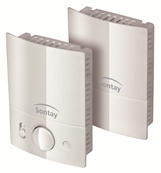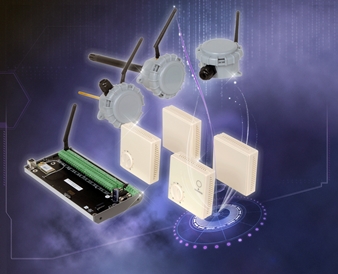|
April 2012
Article
AutomatedBuildings.com
|
[an error occurred while processing this directive]
(Click
Message to Learn More)
|
|
Sensing The Future
Right from their original introduction as the eyes and ears of the BMS,
misconceptions have persisted in terms of how accurate these devices
really need to be, how fast they should react and what precisely
constitutes a high quality room and / or duct sensor.
|

Trevor
S. Palmer,
Managing Director
Sontay
|
Trevor S. Palmer, Managing Director at Sontay, examines the role that
room sensors have played in the rise of the building control system and
looks at the impact of current trends on the design and development of
these devices now and in the years to come.
Over
recent years, we have seen a greater emphasis placed on energy
efficiency especially in the way a building is constructed and
used.
To help consulting engineers, mechanical contractors and architects
meet the new efficiency demands and guide them through the building
process the American Society of Heating, Refrigerating and
Air-Conditioning Engineers (ASHRAE) has compiled a comprehensive list
of standards.
When it comes to air quality and building control there are three
standards which are worth noting. Standard 90.1 provides minimum
requirements for energy efficient designs for buildings, excluding
low-rise constructions. Standard 62.1 ensures minimum ventilation rates
for acceptable indoor air quality in both new build and existing
buildings. Standard 135 requires the use of BACnet, the well known data
communication protocol for building automation and control networks.
With this ever increasing importance on green construction, Building
Management Systems (BMS) have proved vital in meeting the ASHRAE
standards. They combine energy saving control techniques, such as
optimum start and dead bands, with communication and information
systems that allow active management of the building services and the
capability to achieve and maintain a high level of energy efficiency
and lower carbon emissions.
For all the sophistication, advanced feature-sets and benefits that
these control systems bring to their occupants, they are dependant for
their success upon the humble sensor.
Room temperature and humidity sensing and transmitting products began
in conjunction with the development and proliferation of centralised
building management systems in the 1980’s. Traditionally, the
manufacture of these two-wire products was limited to the major
systems’ manufacturers of the day - companies like Honeywell, Johnson
Controls and Barber Coleman (today owned by Schneider Electric).
Right from their original introduction as the eyes and ears of the BMS,
misconceptions have persisted in terms of how accurate these devices
really need to be, how fast they should react and what precisely
constitutes a high quality room and / or duct sensor. These factors are
important and they demand closer consideration from consultants,
contractors and systems integrators charged with delivering energy
efficient control systems for today’s buildings.
As an example, many consulting engineers continue to specify 0-10V
transmitters equipped with PT100 type temperature elements, as
standard. The commonly held view is that these products are more
accurate than box-standard thermistors. In fact, quite the opposite is
true. Thermistors are today available in different grades and types
which quite often exceed the accuracy of transmitters of old.
Measurement accuracy versus stability is another talking point.
Generally speaking, the industry has relied and continues to rely on
temperature sensors which are low cost and tolerate +/- .3 degrees
Celsius over the entire range (-10 to +70). But what is really
important from a sensing perspective is longer term stability rather
than absolute accuracy. It is much more important for devices to remain
accurate within the manufacturer’s specification (+/- .3 degrees) for
the life of the device than their absolute accuracy. After all, these
devices are being applied within commercial buildings to enhance
occupant comfort and improve energy savings over the long term. If our
balance of priorities shifts in favour of performance stability over
absolute accuracy then these benefits can be successfully realised.
Sensor cost also remains an issue. Accounting for just 2% of the budget
for a whole project, room sensors themselves are not always the main
focus of attention when it comes to selecting and specifying the
building control system. However, different price-points often reflect
a differential in quality. Choosing the lowest cost sensor brings with
it the increased risk of compromising on long-term measurement
reliability and performance stability. Device failure can lead to
the time and cost of unnecessary call out and product replacement
issues, alongside the unwanted cost of reputational damage to the
specifying contractor and consultant.
[an error occurred while processing this directive]
Increasingly popular wireless sensor technology is also having a
fundamental impact in transforming how we think about the cost of
sensor installation. By eliminating the need for structural cabling
during sensor installation, wireless devices can greatly reduce
engineering time and installed project cost. This enables faster and
easier installation on new buildings and also opens up the opportunity
for control specialists to retrofit energy efficient HVAC controls into
existing commercial and public buildings. In projects which feature our
SonNet family of wireless sensors, we are typically finding total
installed cost savings of 30% and more over comparable wired sensor
installations. At a time, when reducing costs are a priority on many
projects, proven wireless technology can bring significant
benefit.
Comprising battery powered sensor nodes together with permanently
powered network receivers and routers, and software, this innovative
product range is built on a robust 2.4 GHz, 802.15.4 self-healing,
wireless tree topology. This topology is significant because it
eliminates concerns with reception and reliability often associated
with existing ‘point-to-point’ wireless systems. If a sensor detects a
problem with the signal, it will automatically re-route to find the
strongest available path to the receiver. Interference with other radio
devices in the same frequency spectrum also been addressed through a
proprietary algorithm which continually adapts to site conditions.
Using this type of wireless technology also brings building owners and
facilities managers enhanced site flexibility, allowing for building
layouts to be changed on a regular basis without the need to re-wire
sensor configurations accordingly.
Today, changing aesthetics and increased functionality are also
important drivers in helping us re-evaluate the way that we look at
sensors.
 Up until now, sensors located in the space have been selected with
little or no regard to design aesthetics. The latest devices available
on the market offer an opportunity for specifiers not simply to satisfy
the functional demands of their client but also the impact of the
sensor on the interior space, and the look and feel of these devices.
Take our new range of TT-1000 space temperature sensors. These room
sensors feature a specially designed low profile and curved fascia to
ensure that they can blend stylishly and seamlessly into a room’s
design scheme whilst still helping to deliver greater energy
efficiency, cost savings and carbon reductions in new build and
retrofit building applications. The bland and, frankly, cheap-looking
design of the ordinary room sensor need no longer be a barrier nor an
unwanted intrusion into the design scheme of the upmarket commercial
office building.
Up until now, sensors located in the space have been selected with
little or no regard to design aesthetics. The latest devices available
on the market offer an opportunity for specifiers not simply to satisfy
the functional demands of their client but also the impact of the
sensor on the interior space, and the look and feel of these devices.
Take our new range of TT-1000 space temperature sensors. These room
sensors feature a specially designed low profile and curved fascia to
ensure that they can blend stylishly and seamlessly into a room’s
design scheme whilst still helping to deliver greater energy
efficiency, cost savings and carbon reductions in new build and
retrofit building applications. The bland and, frankly, cheap-looking
design of the ordinary room sensor need no longer be a barrier nor an
unwanted intrusion into the design scheme of the upmarket commercial
office building.
At the same time, the longer term trend is away from single use
sensors, one for temperature and one for humidity, to single,
multi-functional environmental sensors. These modern devices can
measure different important variables within the overall space
conditions which may include air quality, CO2 for occupancy alongside
traditional temperature and humidity measurements. This combined
approach offers numerous advantages to the systems integrator and the
client. The building owner enjoys the ability to monitor and report on
total environmental conditions and yet service only a single device
into the future. He can also minimise the wall acne that will often
occur if multiple devices are required. The systems integrator,
meanwhile, has the ability now to provide much more sophisticated
control strategies at a lower total installed cost with fewer devices
to install and service in the building.
Today’s sensing devices are providing much better aesthetics and
greater functionality for a relatively low – and, in the case of
wireless, significantly lower - total installed cost. These devices are
capable of providing a better picture of the true building conditions
over a long term in smaller, more pleasing to the eye packages. The
result is the creation of a broader market opportunity for control
systems specifiers and installers and, ultimately, the potential for
more energy efficient buildings and reduced carbon emissions for
all.

Editor’s note: Sontay products and control solutions are designed to
help improve building management system performance, reduce energy and
maintenance costs and increase occupant comfort levels. For
further information on the Sontay product range, contact
sales@sontay.com.
About the Author
Trevor
S. Palmer is Managing Director at Sontay and has over 15 years of
combined HVAC controls experience. This extends from expertise in the
application of manufactured solutions to knowledge gained in key sales,
marketing and product development functions at various international
market leaders in the sector. Previously, Trevor has held a senior role
at Canadian-based HVAC controls manufacturer, Viconics, where he was
director of marketing and international sales.
footer
[an error occurred while processing this directive]
[Click Banner To Learn More]
[Home Page] [The
Automator] [About] [Subscribe
] [Contact
Us]

 Up until now, sensors located in the space have been selected with
little or no regard to design aesthetics. The latest devices available
on the market offer an opportunity for specifiers not simply to satisfy
the functional demands of their client but also the impact of the
sensor on the interior space, and the look and feel of these devices.
Take our new range of TT-1000 space temperature sensors. These room
sensors feature a specially designed low profile and curved fascia to
ensure that they can blend stylishly and seamlessly into a room’s
design scheme whilst still helping to deliver greater energy
efficiency, cost savings and carbon reductions in new build and
retrofit building applications. The bland and, frankly, cheap-looking
design of the ordinary room sensor need no longer be a barrier nor an
unwanted intrusion into the design scheme of the upmarket commercial
office building.
Up until now, sensors located in the space have been selected with
little or no regard to design aesthetics. The latest devices available
on the market offer an opportunity for specifiers not simply to satisfy
the functional demands of their client but also the impact of the
sensor on the interior space, and the look and feel of these devices.
Take our new range of TT-1000 space temperature sensors. These room
sensors feature a specially designed low profile and curved fascia to
ensure that they can blend stylishly and seamlessly into a room’s
design scheme whilst still helping to deliver greater energy
efficiency, cost savings and carbon reductions in new build and
retrofit building applications. The bland and, frankly, cheap-looking
design of the ordinary room sensor need no longer be a barrier nor an
unwanted intrusion into the design scheme of the upmarket commercial
office building.